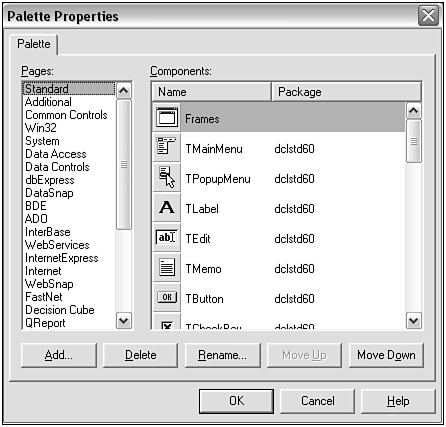Review of the Component Palette
The VCL provides a large and mature family of interactive and noninteractive components for use in your application. These can be found on the IDE component palette.
To make that easier, the component palette is broken into pages, each containing a variety of components. Also, some components only exist on the component palette for specific editions.
-
The Personal Edition contains the core VCL components.
-
The Professional Edition adds the CLX components, the database components (excluding support for Oracle 8i special features), Quick Reports, TeeCharts (graphs), ActionLists and Actions, Office and other OLE Automation Server components, a WebBrowser component, and the Indy Internet components.
-
The Enterprise Edition adds special component features for Oracle, DataSnap components for access to remote data module applications, SOAP, COM, and CORBA-oriented distributed system connection components for use with remote data modules, and Internet Express components to easily use XML with remote data modules.
The pages of the component palette conveniently arrange these more than three hundred components into something manageable.
Figure 3.2 shows the component palette properties dialog, which is produced when you pick Properties from the pop-up menu you get with a right-button press over the component palette.
Figure 3.2. Component palette properties dialog.

The pages contain components as follows (you can see the name of the component in a hint if you hover over the component image on the palette):
-
Standard : Basic user interface components, such as TMainMenu , TPanel , TLabel , TEdit , TMemo , and TButton . These are typically standard Windows/Linux user interface elements.
-
Additional : More user-interface components, offering specialized features not available from standard operating system components. These include special buttons such as TBitBtn and TSpeedButton (extending TButton with images); TMaskEdit (extending TEdit with the capability to enforce a format for input); TDrawGrid and TStringGrid (which provide a scrollable spreadsheet-such as interface object for images and strings, respectively); TImage and TShape , which can be used as graphical elements, and the special Action components.
-
Common Controls and Win32 : There are many useful controls here. They include the TpageControl , which enables you to create multipage user interfaces; TProgressBar , which you can use to show the progress of some noninteractive processing; TimageList , which can contain a set of indexable images for sequential display or use with controls such as TBitBtn . Note that the Common Controls page is for CLX applications only and Win32 for Windows VCL applications only.
-
System : A Windows only page, this contains a variety of specialized Windows controls, including TPaintBox , TMediaPlayer , OLE, and DDE controls.
-
Data Access : This now contains only a relatively small set of components that are used for data access. These include TdataSource , which is used to connect database components to the data-aware controls on the DataControls page); TClientDataSet , which is used when working with client-server database queries, and a set of XML transformation components.
-
Data Controls : These are data-aware versions of standard user interface controls. They can be hooked to a data source that makes the controls capable of displaying data set rows or fields. Controls such as TDBGrid , TDBText (a label-displaying field content), TDBEdit (allowing editing of the content of a field), TDBImage (displaying an image stored in a BLOB field) makes it very easy to connect your application to databases regardless of how they are implemented.
The next four pages offer components that provide similar interfaces, but which use very different methods of accessing data in databases. At one time, C++Builder provided only one type of database access component ”the components now on the BDE page. Now there are several different component sets for database access ”which means more choices. Fortunately, all those components link to the same data aware controls using the TDataSource component on the Data Access page.
-
dbExpress : These are a set of components to interface with the new lightweight client-server database drivers from Borland. Those drivers can work with enterprise databases such as Oracle.
-
DataSnap : These components connect to Remote Data Modules (RDM). RDM are used to form the provider tier of a multitier system. TDCOMConnection enables you to use DCOM to connect to the RDM, and pass data back and forth from the components of the RDM as if they were on the local system. Other types of connection are also provided. DataSnap is discussed in Chapter 21, "DataSnap Multitier Connections ."
-
BDE : These are a set of components to interface with Borland Database Engine drivers, which allow access to databases both directly through the BDE and indirectly through ODBC. Note that the BDE is currently stable ”which means it will not see much if any further development.
-
ADO : This set of components only applies to Windows, where it connects to databases through ActiveX Data Objects.
-
Interbase : This set of components connects to the Borland open source Interbase client-server database.
Multitier applications other than pure database applications are also easy to program using components. The next few pages are dedicated to those sorts of distributed programs:
-
WebServices : These components are used to provide or work with WebServices-enabled applications, which are covered in Chapter 19, "SOAP and Web Services with BizSnap."
-
InternetExpress, Internet, WebSnap, FastNet : These components work with HTML, HTTP, and other Web protocols.
-
Decision Cube : This powerful database component set enables you to provide fairly high-end analytical capabilities to your users.
| |
| |
| Top |